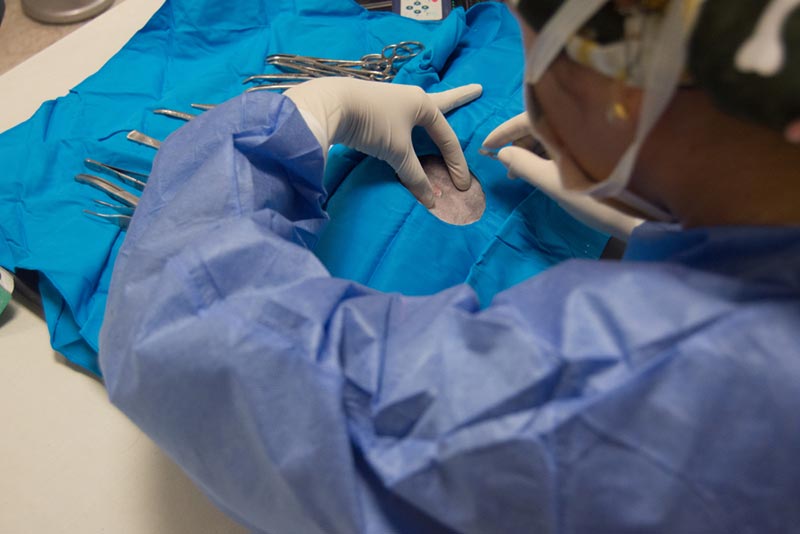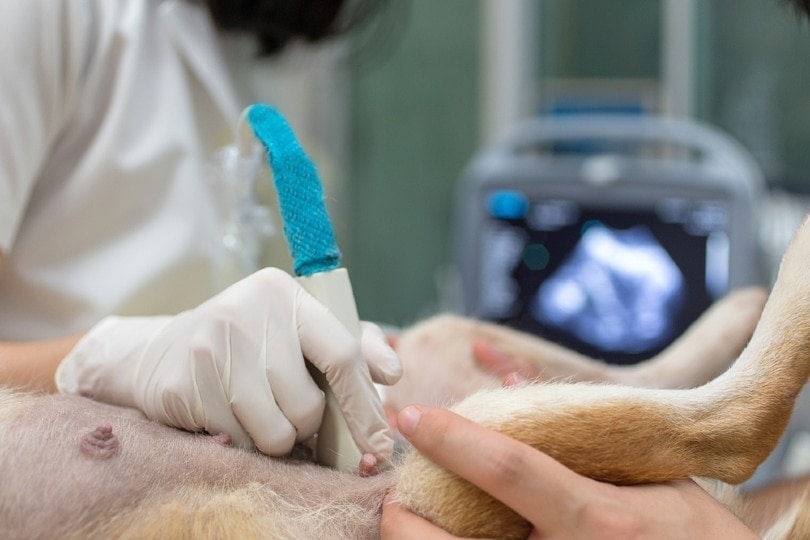Pros & Cons of Spaying Your Female Dog

Updated on

Spaying your female dog is an elective procedure, and you may be trying to decide if it is right for your dog. It’s difficult to think about your pet having to go through surgery and facing the risks involved, but you also know that there are benefits to getting your dog spayed.
It’s not an easy decision that shouldn’t be taken lightly, which is why this article goes over the pros and cons of spaying your female dog, so you can decide which option works best for you and your dog.
What Is Spaying?
Simply put, it is a surgical procedure in which the veterinarian removes the ovaries and uterus from a female dog. The vet makes a small incision in the abdomen to remove the reproductive organs. The procedure can take 15 to 60 minutes, depending upon the size and age of your dog. Some vets can perform a minimally invasive surgery with the laparoscope.
The incision is closed with surgical glue, staples, or sutures and is done in two or three layers to help the tissues heal back together and prevent it from dehiscing (opening). Your dog is given pain medication for the soreness and antibiotics to prevent secondary infections. You will need to keep a close eye on the incision daily and ensure they can not lick or scratch it. Usually, within a week, your dog is able to resume all previous activities.
History of Spaying
The act of sterilizing your dog has improved over the years. The 1930s brought the spaying procedure to the world, and it helped decrease the number of shelters that were congested with too many dogs who would end up being euthanized. It also helped decrease the number of people taking matters into their own hands and putting down unwanted and stray dogs.
There are still issues with too many dogs who don’t have homes and have to be put down, which is why there are many people in favor of spaying female dogs. Nevertheless, there are some responsible pet owners who want to have the choice of whether to spay their dog.
There are many organizations today that focus on developing and providing cheaper and easier ways to spay dogs. The ASPCA provides a listing of local spay and neuter programs within the United States.

Pros and Cons of Spaying
- Prevents unwanted pregnancies
- Prevents infections of the uterus
- No heat periods
- Prevents ovarian and breast cancer
- Prevents false pregnancies
- Prevents overpopulation of pets
- Decreases basal metabolic rate
- Cost of the surgery
- Surgical risks and recovery
- Potential health issues if spayed too early
- Hypothyroidism
- Higher risk of hemangiosarcoma
A Detailed Look: Pros of Spaying
Prevents Unwanted Pregnancies
Of course, the number one benefit or pro of spaying a female dog is to prevent her from getting mounted by a male and becoming pregnant. While puppies are the cutest creatures, they represent a huge responsibility and should never be brought to this world if not planned. Finding a loving family for a litter of puppies is easier said than done, especially these days.
Prevents Uterus Infections
An infection of the uterus is called pyometra, and it is quite common, affecting one out of four female dogs. Pyometra is the result of a thickened uterus lining that forms cysts that secret fluids. This creates an ideal environment for bacteria to grow. It is a serious situation that needs to be treated to prevent death from occurring. The only cure — and prevention — is to spay your female dog.
Prevents Heat Periods
When a dog is in heat, you will have to deal with certain issues that can be frustrating. Just before her heat, your dog will have bloody discharge from her vulva, and she will most likely spend a great deal of time licking her private areas because the genitals are swollen. A male dog can smell a female in heat from a long distance, and it can be difficult to keep the male from getting into your backyard. Your dog will also be receptive to other dogs and try to encourage them to mount her. This can be particularly embarrassing when going for walks.

Prevents Ovarian Cancer and Breast Cancer
With the uterus and ovaries removed, there is no chance of your dog getting cancer of these parts, but it can also decrease her risk of breast cancer if you have her spayed before she is 2.5 years old or before she experiences her first heat. Mammary gland tumors are the most common type in female dogs.
Promotes Less Aggressive Behavior
With the decreased production of hormones, your dog will be less likely to exhibit aggressive behavior such as biting or dominance. Your dog will be easier to manage and more laidback.

Prevents False Pregnancies
Besides preventing the real thing, false pregnancies will also be eliminated. A false pregnancy can occur a few weeks after your dog goes into heat. The mammary glands can even produce milk, which can put your dog at risk for mastitis (infection of the mammary gland).
Prevents Overpopulation of Pets
Even if you have good intentions to keep your dog secluded when she is in heat, what happens if she does become pregnant? It can be difficult to find homes for puppies, especially since more and more people want purebreds. The last thing you want to do is increase the pet population within shelters — there are already many dogs waiting to be adopted.

Decreases Their Basal Metabolic Rate
The number of calories your dog needs after being spayed decreases because without the action of sexual hormones, their basal metabolic rate decreases (BMR) after surgery. Basically, your dog won’t need to eat as much. If your dog experiences weight gain, this means they aren’t getting enough exercise and/or their portions haven’t been adjusted to account for the decreased BMR.
A Detailed Look: Cons of Spaying
Surgery Can Be Expensive
There is some expense involved with spaying your dog, but many vet clinics and shelters offer discounts for people with financial concerns. The surgery can cost anywhere from $50 to over $300, depending on your location. If your dog is obese, has diabetes, or is in heat at the time of the surgery, the cost could increase by $50 or more.
Spaying or neutering is only one of many vet procedures your pets may need over the course of their lives. All of those vet visits can be pricey, but you can manage the cost with the help of a good pet insurance plan. The customized options from Spot may help you keep your pet healthy at a reasonable price.
Surgery Carries Risk
There are risks involved with any type of surgery, such as a reaction to the anesthesia or complications during the operation. Recovering from the surgery also poses risks, and it will take time for your dog to feel better. If stitches are used on the incision, there is a chance that your dog will bite or claw them out. But a cone will usually be placed on your dog to prevent this from happening.
It’s worth mentioning that with modern medical protocols, the risks are considerably lower than years ago.

Spaying Too Early Will Cause Health Issues
If you have your dog spayed before she has had time to develop fully, she may experience health issues later on in life. The reproductive hormones assist in the formation of bones, joints, and organs. To prevent the risk of hip dysplasia, torn ligaments, urinary incontinence, and bone cancer, don’t spay until she has matured. Your veterinarian can help you decide when the appropriate time may be.
Spaying Can Cause Hypothyroidism
The reproductive organs affect the endocrine system, which can cause low thyroid levels — called hypothyroidism. You can have your dog tested if she exhibits signs; the condition is treated with daily thyroid medication.
Increased Risk of Hemangiosarcoma
Spayed females seem to be at higher risk of developing a cancer called hemangiosarcoma, which is deadly if it develops in the spleen or the heart. The overall incidence of this cancer is low however certain breeds—such as the Labrador Retriever, Boxer, Bulldog, and Afghan Hound, to name a few — develop this cancer more frequently.
Certain Breeds Aren’t Protected From a Deadly Cancer
The reproductive organs protect against a cancer called hemangiosarcoma, which can develop in the spleen or the heart. It doesn’t mean they will get this cancer, of course, it just means that they are at a higher risk. Certain breeds — such as the Labrador Retriever, Boxer, Bulldog, and Afghan Hound, to name a few — develop this cancer more easily.

Conclusion
After reading through the pros and cons of spaying your dog, we hope that it helps you reach an informed decision about whether you should do it. Speaking with your veterinarian can also offer more insight.
The disadvantages aren’t meant to scare you, and some of the possible advantages don’t occur in all dogs. When it comes to the pros and cons of spaying, you have to decide if the benefits outweigh the risks.
Related Reads:
- How to Calm a Male Dog When a Female Is in Heat (8 Effective Tricks)
- Top 10 Most Aggressive Dog Breeds in the World: Vet-Approved Facts
Featured Image Credit: AndresDica, Shutterstock














